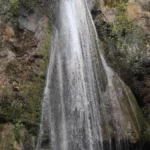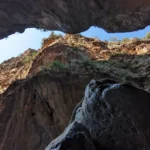Quick search
CTRL+K
Quick search
CTRL+K
The Mylonas or Saint John Gorge is situated 18km to the east of Ierapetra. It commences near the St. John village at a height of 500m and concludes at the Kakia Skala beach. It is not feasible to descend the gorge from Saint John due to a tall waterfall, necessitating the use of canyoning equipment.
Nonetheless, there are two ascending trails that start near the Kakia Skala beach, providing access to the high fall of the Mylonas canyon. The first trail (easy – 20’) takes you through the pine-wooded side of the gorge, a large portion of which is the old concrete ditch, formerly used to transport water to Koutsounari. The other trail follows the riverbed and can be quite exhausting, especially in winter (takes approximately 1:30 hour).
Upon reaching the end of the ascending trails at a height of 300m, you will encounter the tall fall of Milonas, which stands at 20m. Below it, you will find a small pond filled with crystal-clear water, perfect for a refreshing swim. In winter, and after heavy rainfall, a second waterfall appears to the left of the main fall, creating a breathtaking view.

The Havgas Gorge, situated near the village of Kalamafka and just 12km north of Ierapetra city, is one of several gorges with the same name scattered across Crete. Other examples include the Havgas Gorge in the Lassithi Plateau, Plaka, and Kavoussi. The Havgas Gorge is nestled between the Megali Korfi (1103m) and Kokies (993m) peaks, and its stream, the Kapsous, serves as the primary tributary of the Kalamavkianos River that empties into the Stomio beach of Gra Ligia.
This stunning canyon boasts unique rock formations, sculpted by rare geological events. Many of these rocks are adorned with nature’s own “artwork”, etched over time by the elements. Despite its relatively short length, the gorge offers an easy and enjoyable walk along the riverbed, even for novices. The area’s altitude of around 500m provides the perfect environment for a lush pine forest. Regrettably, repeated fires have caused the forest to diminish in size. Nevertheless, the area is worth a visit, and visitors are sure to be charmed by the sight of small pine trees sprouting from the rocks, akin to bonsai trees.
The gorge’s depth extends to 300m. At one spot, two narrow rocks form the entrance to a series of caves that served as a refuge for Cretan rebels and Allies during the German Occupation. The locals refer to this area as the “Chinese Landscape”, due to the smooth rocks dotted with bonsai-like trees. Adjacent to the gorge’s exit, visitors can explore the village of Kalamafka with its inviting taverns and babbling water. Additionally, nearby attractions include an ancient olive oil mill and the churches of Saint John and Saint Anthony.

Ha Gorge, a mesmerizing natural wonder carved into the western side of Mount Thrypti, channels water from the Thripti plateau to the Pachia Ammos beach. The gorge’s journey commences near the Saint Anne Byzantine church and the E4 footpath at approximately 800m altitude, and concludes near the Monastiraki village, about 100m above sea level.
Traversing the Ha Gorge demands canyoneering skills and specific gear due to its series of cascading waterfalls, including a 35m high plunge. The gorge tightens to a mere thirty centimetres at certain points, squeezed between cliffs that rise to 400 meters. The Mastoras waterfall, one of Greece’s tallest free falls reaching 215m, contributes substantial water midway through the route.
For those with less experience, a hike from the Monastiraki exit of the gorge provides a peek into its splendour, leading to a charming pond at the base of the final waterfall and past ancient grain mills. The name of the gorge, Ha, originates from the Greek verb “Hasko,” which means to create a gap. However, local folklore offers vibrant alternative explanations. From stories of misleading Saracens to myths of a golden chariot hidden deep within, the Ha Gorge is not only a stunning natural spectacle but also a symbol of intriguing local mythology.

Commencing from the west of the village of Skinokapsala, at the Kipos spot, lies the petite yet fairly broad Ahlia gorge. This gorge, blanketed by pine trees, concludes at the Ahlia beach, also referred to as Galini. Throughout the winter season, the Thripti Range feeds a river with its waters, creating a string of waterfalls that vary in height from 5 to 8 meters. The gorge’s sandstone walls are wide enough to make hiking a breeze, eliminating the need for any canyoning gear.

This magnificent natural phenomenon – Sarakina Gorge – can be found near the traditional village of Mythi and the coastal settlement of Myrtos, where the Kryos river merges with the sea.
As the tale goes in Greek mythology, Zeus’s son, the giant Sarantapihos, once paused to quench his thirst from the Myrtos or Kryos river, near Ierapetra. His sweeping beard slashed the mountain, dividing it into two parts, thereby forming the Sarakina canyon.
Regarded by many visitors as Crete’s most captivating hiking gorge, Sarakina may only stretch 1.5km, but within this concise journey, one encounters an awe-inspiring spectacle of nature, a natural sculpture painstakingly crafted by water over countless years. The canyon boasts towering walls that rise up to 150m high and extremely narrow passages often found in technical gorges that require canyoneering equipment. The width of Sarakina fluctuates between 3 to 10 meters, rarely extending beyond these points.
The majority of the canyon is accessible to explorers of all abilities, featuring water, pools, and a handful of climbing points that necessitate careful navigation. A standout feature is the abundant water almost all year round, creating picturesque waterfalls and ponds perfect for a refreshing dip, even in the summer. In winter, traversing the gorge without getting soaked is a challenge. As one embarks on the route, they’ll encounter the need to climb, navigate immense boulders, and cross rocky bridges. Carved stone stairs and tree trunks are present in tricky spots to facilitate easier climbing.

No results available
ResetNo results available
Reset© All rights reserved. Crete Locals